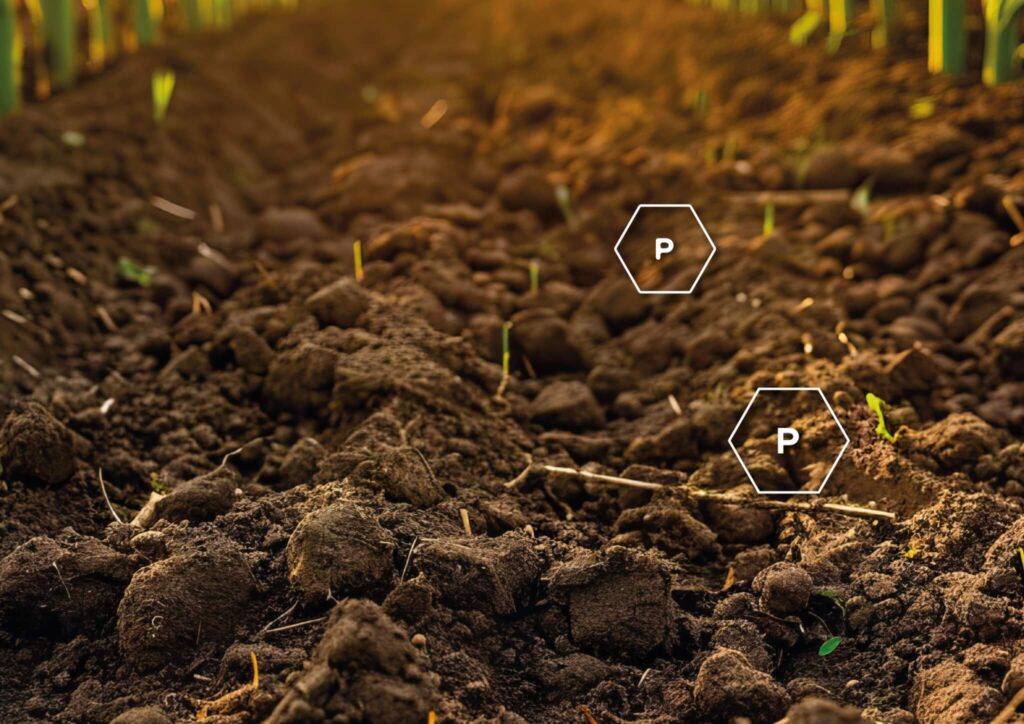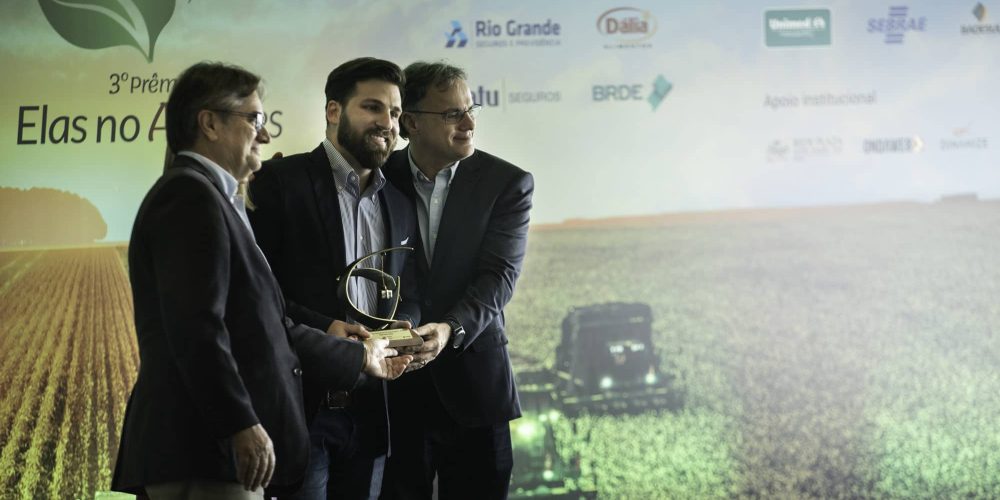Phosphorus (P) is one of the nutrients that deserves attention for agricultural production in soils in general. Under natural conditions, these soils have low availability (COSTA, 2022). Therefore, an adequate supply of P becomes essential for achieving greater productivity, in addition to being fundamental to supplying the phosphorus deficiency in the soil (BENDER, 2013; OLIVEIRA, 2018; SOUSA et al., 2016).
Soils in tropical regions almost always have high adsorption capacity and low phosphorus levels, which makes phosphate nutrition a limiting factor in obtaining economically satisfactory agricultural yields (DA COSTA et al., 2006). The availability of phosphorus applied as fertilizers is generally limited due to the abundance of iron and aluminum oxides in these soils. Several reactions are involved in this limitation of availability, such as precipitation (formation of a new phase or defined compound), adsorption (reaction at the solid/solution interface) and diffusion in crystal imperfections (PARFITT, 1989; ALMEIDA et al., 2003). Soil attributes, nutrient transport in the soil, morphology, physiology of the root system and rhizosphere microbiota are factors directly related to phosphorus absorption by the plant.
The main mechanism of phosphorus transport in the soil is diffusion, which is influenced by several factors, such as: the volumetric water content in the soil, the phosphorus-soil colloid interaction, the distance to the roots, the element content and the soil temperature (DA COSTA et al, 2006). In general, very low values of phosphorus transport are recorded, due to its strong interaction with soil colloids, especially in very weathered tropical soils; thus, the low mobility of the nutrient has constituted a problem for the phosphate nutrition of crops (PARFITT, 1989; KAMPF and CURY, 2003; AZEVEDO et al., 2004).
The labile fraction (Figure 1) is represented by the set of phosphate compounds capable of rapidly replenishing the soil solution when it is absorbed by plants or microorganisms. Therefore, the most labile fractions depend on the degree of soil weathering, mineralogy, texture, organic matter content, physical-chemical characteristics, biological activity and predominant vegetation (WALKER and SYERS, 1976; CROSS and SCHLESINGER, 1995).

Figure 1- Forms and proportion of phosphorus in the soil. Source: UNESP.
With the application of phosphate fertilizers and consequent adsorption to colloids, soil management plays an important role in prolonging its lability, since some practices can be adopted to reduce its specific adsorption, such as not turning the soil, controlling erosion and maintaining the soil's plant cover (CÂNDIDO, 2011) and using limestone. P adsorption occurs first in the sites most avid for the element and, subsequently, the remaining P is redistributed into retained fractions with lower binding energy, with greater bioavailability (RHEINHEIMER and ANGHINONI, 2001).
Phosphorus (P) is found in soil in two main forms: inorganic and organic (GATIBONI et al., 2008). Inorganic P forms mainly comprise those adsorbed to the functional groups of inorganic colloids, through monodentate, bidentate and binucleate bonds (PARFITT, 1978), whose binding energy with the colloids increases, in this and inverse order, their lability. Organic P forms (Po) represent phosphate ions bound to organic compounds, and their lability is directly related to the susceptibility of decomposition of the organic radical to which the phosphate is bound. Thus, diester phosphates are quite susceptible to microbial attack and make up the “pool” of labile P in the soil. However, compounds that have a high residual charge, such as monoester phosphates, are strongly adsorbed to inorganic colloids and remain chemically and physically protected from microbial attack (STEWART and TIESSEN, 1987).
When using the technique of fractionation of soil P forms, it has been observed that fertilizers added to the soil accumulate mainly in inorganic forms (RHEINHEIMER and ANGHINONI, 2001). In well-fertilized or slightly weathered soils, these can be the main source of P for plants, while in soils with low levels of available P, organic P becomes relevant to the system (GATIBONI et al., 2007; RHEINHEIMER et al., 2008). According to Tiessen et al. (1984), in slightly weathered soils, the contribution of organic P is 14% to plant nutrition, while in older soils it can reach 80%. Additionally, Beck & Sanches (1994) observed that in soils with phosphate fertilization, the contribution of organic P is 9%, increasing to 34% in systems without fertilization. Similarly, Gatiboni et al. (2005) report that, in fertilized soils, the contribution of organic P to plant nutrition was 6%, and increased to 43% in soil without the addition of mineral fertilizers.
Thus, the poorer the system in available P, the greater the dependence on organic forms, including P stored in microbial biomass (GATIBONI et al., 2008). This is a very dynamic P compartment that adsorbs and immobilizes P from the soil solution when availability increases in the system, but gradually releases it through the adjustment of the microbial population to the supply of energy and P in the system (CONTE et al., 2002; MARTINAZZO et al., 2007). The acquisition of organic P by soil microbial biomass can occur through total degradation of the organic matter in the system or through specific mineralization of organic phosphate through the action of phosphatase-type exoenzymes (MCGILL and COLE, 1981).
Most of the P applied to the soil, coming from fast-soluble fertilizers, is retained in clay mineral particles and organic compounds (DE OLIVEIRA et al., 2021). This results in the formation of P fractions in the soil that are hardly available to plants. Thus, the search for new sources of P that can promote the maintenance of soil productive capacity has become very important (DAMACENO et al., 2019).
The application of organic fertilizers as a source of P is noteworthy due to their low cost and gradual release of nutrients into the soil (BOEN and HARALDSEN, 2013). Organic sources have provided increases in soybean and grass production, as well as a significant increase in Ca, Mg and P levels in the soil. In addition, they can potentially alter the dynamics of P in the soil to increase availability to plants (BOITT et al., 2018; DAMACENO et al., 2018).
To understand the behavior of soil P forms, fractionation is a technique that allows identifying the dynamics of the transformations of this element in the soil, depending on the management, soil classes and fertilization adopted (DE OLIVEIRA et al., 2021). The method is used because it is believed that phosphate fertilizers in contact with the soil for long periods undergo modifications, in which different residual fractions are accumulated in the soil with different degrees of binding energy (HEDLEY; STEWART; CHAUHAN, 1982; PARTELLI et al., 2009 and TOKURA et al., 2011). Evidence shows that there is a synergistic effect when the application of phosphate fertilizers is associated with the addition of some organic compound, increasing the concentration of available phosphorus in the soil, which can relate the forms of P in the soil to its availability for plants and reduce the dose of mineral fertilizer (GATIBONI et al., 2007).
In order to plan the management of phosphate fertilization, it is essential to relate the result of the soil analysis with the correct classification in its availability class. The availability classes are obtained by taking into account the nutrient content in the soil and the productivity of the crops under those conditions. Therefore, they depend on a set of experiments with several crops and in different soils, which will provide support for the calibration. The fertilizer dose is established based on the amount of organic or mineral fertilizer necessary for the nutrient level to reach values equal to the optimum. The phosphorus availability classes adopted for the no-till system are obtained with information from conventional cultivation, without their own calibration (SANTOS et al., 2008).
Soil P fractionation has been used to study the different fractions of the element. The method proposed by Hedley et al. (1982) has the advantage of relating the forms of P in the soil to their availability to plants, in addition to quantifying the labile organic P in the soil (TOKURA et al., 2002). This method determines several fractions of P in the soil with a decreasing degree of availability to plants: P forms extracted by resin and sodium bicarbonate are considered the most labile fractions; next come those extracted by sodium hydroxide, which are moderately labile fractions, including P associated with Al and Fe oxides; then, those extracted by acid are bound to apatite and other less reactive Ca phosphates; finally, the P determined by peroxide/sulfuric digestion represents the most recalcitrant phosphate, which cannot be extracted in the previous fractions (ARAÚJO et al., 2004). In this context, studies that aim to determine the different fractions of P in the soil make it possible to understand the behavior of the nutrient, which can, within the adopted production system, indicate more efficient management of fertilization (CÂNDIDO, 2011).
According to Schmidt et al. (1997), the Hedley et al. (1982) method is used to obtain information on the availability of P in the short and long term, through the values of the various P fractions, of various degrees of availability for plants, and can also be used to monitor changes in the forms of P, as a result of processes in the soil (ARAÚJO and SALCEDO, 1997). Interest in using this method to study the dynamics of P in soils of tropical and subtropical regions has increased and involves, especially, the use of fertilizers and soil management (RHEINHEIMER et al., 2000).
In tropical soils, any type of management that increases the absorption and use of P by plants is important for agriculture. One alternative proposed and studied has been the use of mycorrhizae, among other factors, by the exploration of a greater volume of soil and the capacity of hyphae to absorb P in low concentrations, favoring plant growth in suboptimal conditions of this element (Figure 2) (SIQUEIRA, 1994). In Latosols, Alves (1988) found that stylosanthes use P-Al and brachiaria, in addition to P-Al, P-Fe in the process of phosphorus absorption. According to this author, mycorrhizal plants use more efficiently the P less available in the soil, mainly the forms bound to Fe and aluminum.

Figure 2 – Schematic representation of the main physiological factors associated with plant roots and soil microorganisms that influence P availability.
Source: Mendes; Reis Junior, (2003), apud Richardson, (2001).
Although this symbiosis has a broad effect on the phosphate nutrition of plants, the magnitude of the benefits of mycorrhization depends on several factors, including the levels of P in the soil and the plant species (SIQUEIRA, 1994). Knowing the effect of phosphate fertilization on the P fractions in the soil, and other factors that influence these fractions in the soil, such as mycorrhizae, helps to obtain important information on the management of this nutrient (SILVA, et al., 2003).
The AZOGEL matrix that gives rise to the ILSA BRASIL line of solid fertilizers has a high concentration of amino acids. The organic acids of these amino acids bind in the soil mainly to iron and aluminum oxides, in the same place as phosphorus. This contributes to the release of non-labile phosphorus and prevents the phosphorus present in the fertilizer from being adsorbed.
References
ALMEIDA, JA; TORRENT, J.; BARRON, V. Chemistry of soils with variable charge. Piracicaba, SP: ESALQ, 2003.
ALVES, GLN Vesicular-arbuscular mycorrhiza in the growth and utilization of soil phosphorus by Brachiaria and Stylosanthes. 1988. 42 p. Dissertation (Master in Soils and Plant Nutrition) – Federal University of Lavras, Lavras, 1988.
ARAÚJO, MSB; SALCEDO, IH Preferential forms of phosphorus accumulation in soils cultivated with sugarcane in the Northeast Region. Brazilian Journal of Soil Science, Campinas, v. 21, n. 4, p. 643-650, Oct./Dec. 1997.
AZEVEDO, WR et al. Phosphorus availability for flooded rice under residual effect of limestone, gypsum and farmyard manure applied to bean crops. Brazilian Journal of Soil Science, v. 28, p. 995-1004, 2004.
BECK, MA; SANCHES, PA Soil phosphorus fraction dynamics during 18 years of cultivation on a Typic Paleudult. Soil Science, v.34, p.1424-1431, 1994.
BENDER, RR et al. Nutrient uptake, partitioning, and remobilization in modern, transgenic insect‐protected maize hybrids. Agronomy Journal, vol. 105, no. 1, p. 161-170, 2013.
BOEN, A.; HARALDSEN, TK Meat and bone meals and biosolids as slow-release phosphorus fertilizers. Agricultural and Food Science, vol. 22, no. 2, p. 235-246, 2013.
BOITT, Gustavo et al. Fate of phosphorus applied to soil in pig slurry under cropping in southern Brazil. Geoderma, v. 321, p. 164-172, 2018.
CANDIDO, Clebson Santos. Phosphorus dynamics in different soil management systems. 2011. Doctoral Thesis. UEMA.
CONTE, E.; ANGHINONI, I.; RHEINHEIMER, DS Phosphorus of microbial biomass and acid phosphatase activity after phosphate application in soil under no-tillage system. Brazilian Journal of Soil Science, v.26, p.925-930, 2002.
COSTA, Thiago Barbosa et al. PARCELLING OF PHOSPHATE FERTILIZATION IN CORN CROP IN CERES (GO). GOIANO FEDERAL INSTITUTE – CERES CAMPUS. 2022.
CROSS, AF; SCHLESINGER, WH A literature review and evaluation of the Hedley fractionation: Applications to the biogeochemical cycle of soil phosphorus in natural ecosystems. Geoderma, v.64, p.197-214, 1995.
DA COSTA, José PV et al. Diffusive flux of phosphorus as a function of doses and soil moisture. Brazilian Journal of Agricultural and Environmental Engineering, v. 10, p. 828-835, 2006.
COLPO GATIBONI, Luciano et al. Phosphorus Forms and Availability Assessed by 31P‐NMR in Successfully Cropped Soil. Communications in Soil Science and Plant Analysis, v. 36, no. 19-20, p. 2625-2640, 2005.
DAMACENO, João Batista Dias et al. Production of Brachiaria ruziziensis biomass fertilized with calcined bone meal under acid treatments. Agrogeoenvironmental Magazine, v. 10, no. 1, p. 83-93, 2018.
DAMACENO, João Batista Dias et al. Agronomic efficiency of bone meal under acidification in Brachiaria ruziziensis dry matter production in western amazon. Journal of Experimental Agriculture International, v. 34, n. 4, p. 1-7, 2019.
DE OLIVEIRA, Lara Caroline Alves et al. Phosphorus fractions as a function of the use of phosphate fertilizers in different soil classes. Journal of Agribusiness and Environment, v. 14, n. 4, p. 1-15, 2021.
GATIBONI, Luciano Colpo et al. Bioavailability of phosphorus forms accumulated in soil under no-tillage system. Brazilian Journal of Soil Science, v. 31, p. 691-699, 2007.
GATIBONI, Luciano Colpo et al. Microbial biomass phosphorus and acid phosphatase activity during soil available phosphorus decrease. Brazilian Agricultural Research, v. 43, p. 1085-1091, 2008.
HEDLEY, MJ; STEWARD, WB; CHAUHAN, BS Changes in inorganic and organic soil phosphorus fraction by induced cultivation practices and laboratory incubation. Soil Science Society of America Journal, Madison, vol. 46, no. 5, p. 970-976, Sept./Oct. 1982.
KAMPF, N.; CURI, N. Clay minerals in Brazilian soils. CURI, N.; MARQUES, JJ; GUILHERME, LRG; LIMA, J.M., p. 1-54, 2003.
MARTINAZZO, Rosane et al. Soil microbial phosphorus under no-tillage system in response to the addition of soluble phosphate. Brazilian Journal of Soil Science, v. 31, p. 563-570, 2007.
MCGILL, WB; COLE, CV Comparative aspects of cycling of organic C, N, S and P through soil organic matter. Geoderma, v. 26, no. 4, p. 267-286, 1981.
MENDES, I. de C.; REIS JUNIOR, FB dos. Microorganisms and phosphorus (P) availability in soils: a critical analysis. Planaltina, DF: Embrapa Cerrados, 26 p.,2003.
PARFITT, RL Phosphate reactions with natural allophane, ferrihydrite and goethite. Journal of Soil Science, v. 40, n. 2, p. 359-369, 1989.
PARTELLI, Fábio Luiz et al. Quality of organic matter and distribution of phosphorus in the soil of organic Conilon coffee plantations. Rural Science, v. 39, p. 2065-2072, 2009.
RHEINHEIMER, DS; ANGHINONI, I.; KAMINSKI, J. Depletion of inorganic phosphorus of different fractions caused by successive extraction with resin in different soils and management systems. Revista Brasileira de Ciência do Solo, Viçosa, MG, v. 24, n. 2, p. 345-354, Apr./Jun. 2000.
RHEINHEIMER, Danilo dos Santos; ANGHINONI, Ibanor. Distribution of inorganic phosphorus in soil management systems. Brazilian Agricultural Research, v. 36, p. 151-160, 2001.
SANTOS, Danilo Rheinheimer dos; GATIBONI, Luciano Colpo; KAMINSKI, João. Factors affecting phosphorus availability and phosphate fertilization management in soils under no-tillage system. Rural Science, v. 38, p. 576-586, 2008.
SIQUEIRA, JO Arbuscular mycorrhizae. In: ARAUJO, RS; HUNGRIA, M. (Ed.). Microorganisms of agricultural importance. Brasília: Embrapa-CNPAF/ Embrapa-CNPSo, 1994. p. 151-194.
SILVA, Meire Adélia da et al. Phosphorus fractions in Latosols. Brazilian Agricultural Research, v. 38, p. 1197-1207, 2003.
SCHMIDT, JP; BUOL, SW; KAMPRATH, EJ Soil phosphorus dynamics during 17 years of continuous cultivation: a method to estimate long-term P availability. Geoderma, Amsterdam, v. 78, no. 1/2, p. 59-70, July 1997.
OLIVEIRA, LEZ de. Bioavailability of residual phosphorus in different soil and fertilization managements. 2018.
SOUSA, DMG; REIN, TA; SANTOS JUNIOR, J. Phosphate fertilization management for annual crops in the cerrado. 2016.
RHEINHEIMER, DS; ANGHINONI, I. Distribution of inorganic phosphorus in soil management systems. Brazilian Agricultural Research, Brasília, v. 36, p. 151- 160, 2001.
TIESSEN, HJWB; STEWART, JWB; COLE, CV Pathways of phosphorus transformations in soils of differing pedogenesis. Soil Science Society of America Journal, v. 48, no. 4, p. 853-858, 1984.
TOKURA, Alessandra Mayumi et al. Phosphorus forms in soil under no-tillage according to depth and cultivation time. Brazilian Agricultural Research, v. 37, p. 1467-1476, 2002.
TOKURA, Alessandra Mayumi et al. Dynamics of phosphorus forms in soils with contrasting texture and mineralogy cultivated with rice. Scientific Act. Agronomy, v. 33, p. 171-179, 2011.
WALKER, TW; SYERS, JK The fate of phosphorus during pedogenesis. Geoderma, v.15, p.01-19, 1976.
Authors:
Agr Eng. Dr. Angélica Schmitz Heinzen
Agricultural Eng. Msc. Thiago Stella de Freitas
Agricultural Engineer Tuíra Barcellos






